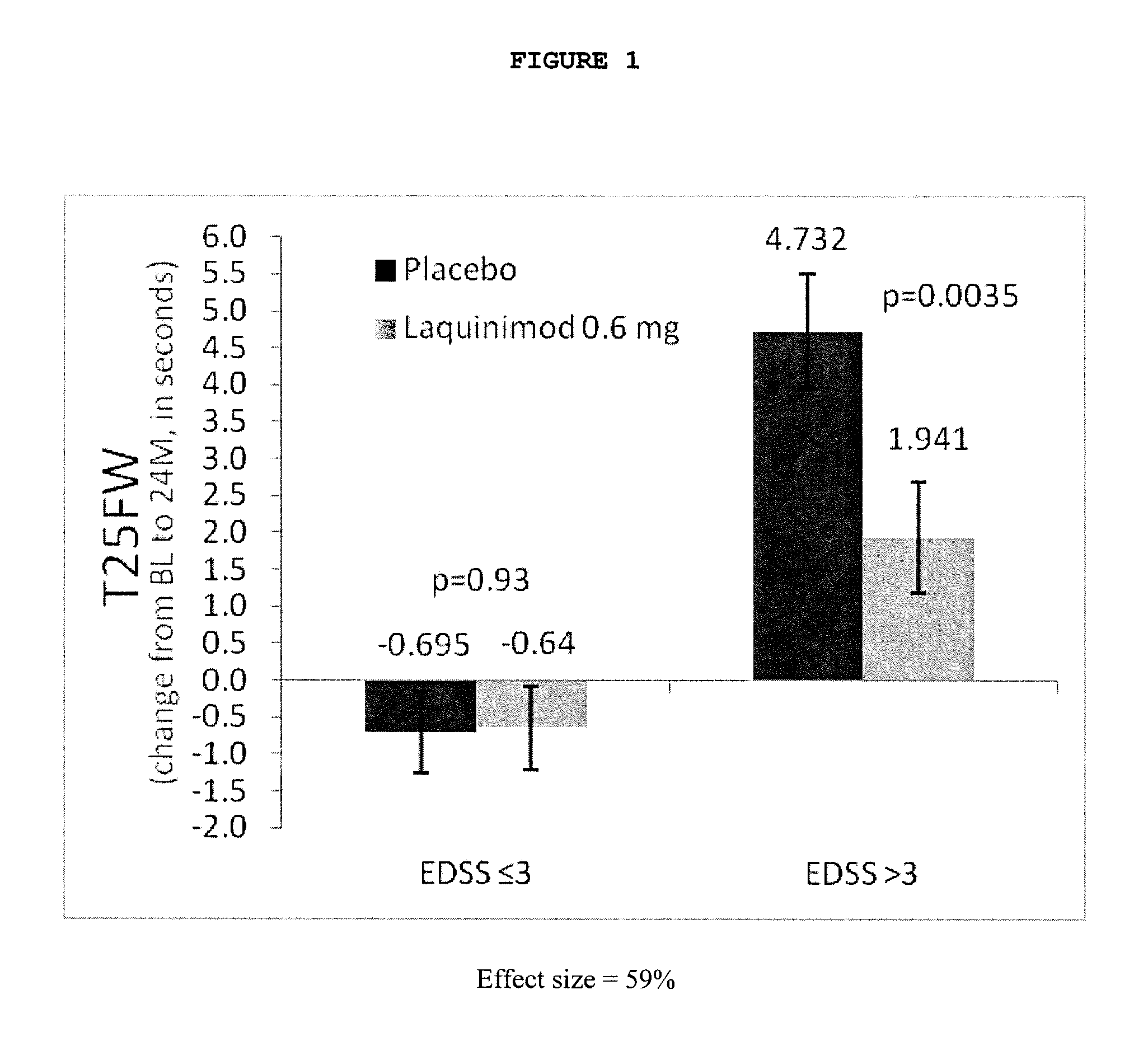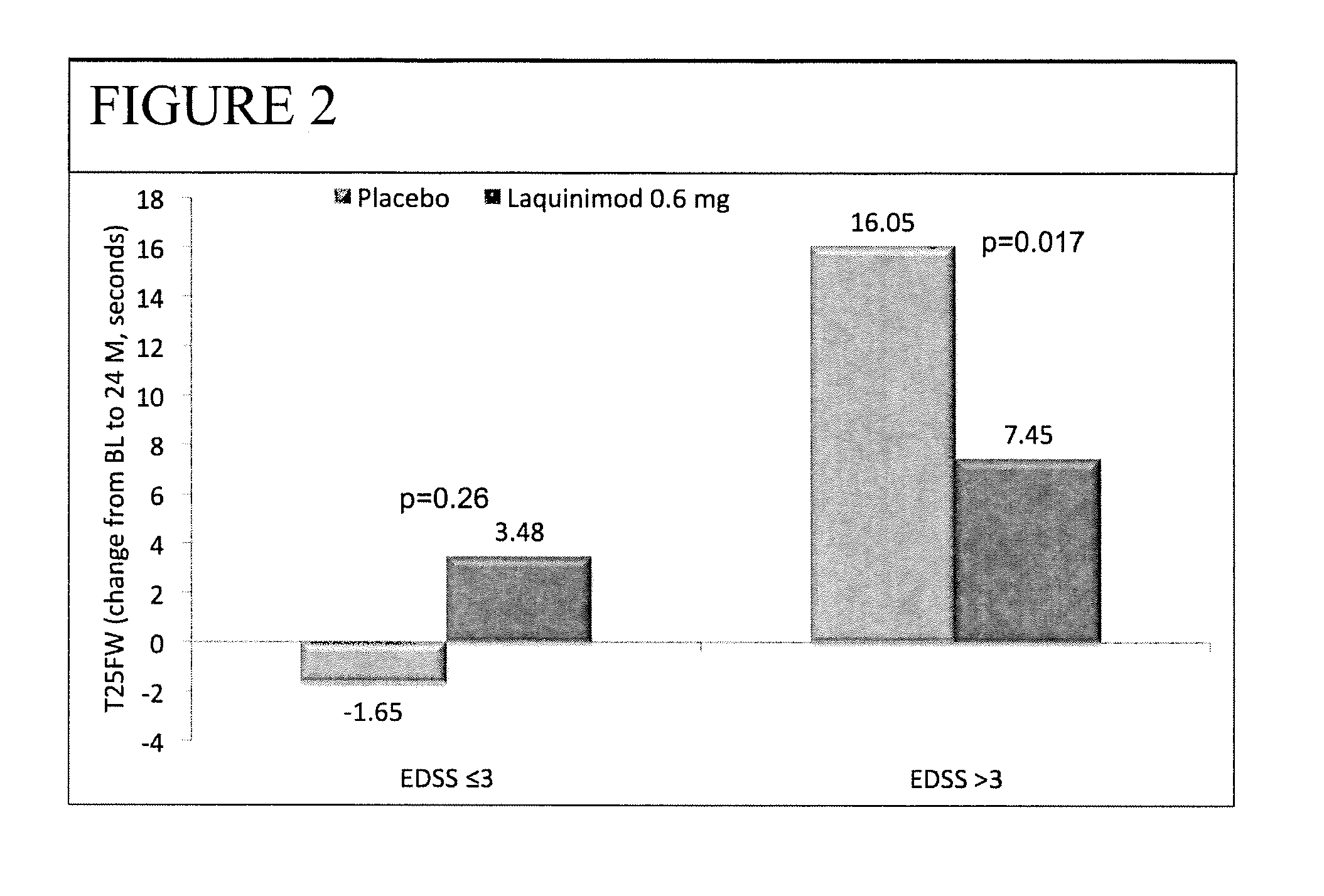Laquinimod for the treatment of relapsing-remitting multiple sclerosis (RRMS) patients with a high disability status
- Summary
- Abstract
- Description
- Claims
- Application Information
AI Technical Summary
Benefits of technology
Problems solved by technology
Method used
Image
Examples
example 1
Clinical Trial (Phase III)—Assessment of Oral Laquinimod in Preventing Progression of MS
[0137]A multinational (24 countries), multicenter (approximately 139 sites), randomized, double-blinded, parallel-group, placebo-controlled clinical trial (“ALLEGRO” or MS-LAQ-301) was conducted to evaluate the efficacy, safety and tolerability of daily oral administration of laquinimod 0.6 mg in subjects with relapsing remitting multiple sclerosis (RRMS) for a 24 months duration.
[0138]One thousand one hundred and six (1106) patients were equally randomized to either laquinimod 0.6 mg or placebo and treated in a double-blind manner and baseline characteristics were balanced between groups. The primary endpoint of the study was the number of confirmed relapses during the double-blind treatment period, which corresponds to the annualized relapse rate (ARR−number of relapses divided by total exposure of all patients). Secondary endpoints included disability as measured by Expanded Disability Status ...
example 2
Clinical Trial (Phase III)—Benefit-Risk Assessment of Avonex® and Laquinimod
[0290]A multinational, multicenter, randomized, parallel-group, clinical trial is performed in subjects with RRMS (“BRAVO”). BRAVO was conducted to assess the efficacy, safety and tolerability of laquinimod over placebo in a double-blinded and rater-blinded design and of a reference arm of Interferon β-1a (Avonex®). The study was also conducted to perform a comparative benefit / risk assessment between oral laquinimod and injectable Interferon β-1a (Avonex®).
[0291]The primary objective of the study was to assess the efficacy of 0.6 mg daily dose of laquinimod in subjects with RRMS as measured by the number of confirmed relapses during the treatment period. Secondary objectives of the study included assessing the effect of 0.6 mg daily dose of laquinimod on the accumulation of disability, as assessed by the MSFC score at the end of the treatment period; assessing the effect of 0.6 mg daily dose of laquinimod on...
example 3
Post Hoc Analysis of ALLEGRO and BRAVO Trials: Evaluation of Laquinimod Efficacy in Patient Subgroups
Introduction
[0486]Natural history data show that once EDSS of 3 is reached, disability progression becomes both more likely and more rapid (Pittock et al. Neurology 2004; 62:51-9; Pittock et al. Neurology 2004; 62:601-6; Leray et al. Brain 2010; 133:1900-1913). At EDSS>3, chronic diffuse inflammation may be a more important driver of disability.
[0487]Patients with an EDSS score of ≦3 are fully ambulatory; however gait dysfunction is common in multiple sclerosis and is a key component of disability progression beyond this stage. Patients beyond this stage experience growing motor impairment. Patients with an EDSS of 3.5 are fully ambulatory but already manifest moderate disability in selected functional systems. Patients with an EDSS of 4 experience some restriction in ambulation, but are up and about most of the day despite clear neurological dysfunction. Subsequent EDSS progression ...
PUM
| Property | Measurement | Unit |
|---|---|---|
| Time | aaaaa | aaaaa |
| Power | aaaaa | aaaaa |
| Mass | aaaaa | aaaaa |
Abstract
Description
Claims
Application Information
 Login to View More
Login to View More - R&D
- Intellectual Property
- Life Sciences
- Materials
- Tech Scout
- Unparalleled Data Quality
- Higher Quality Content
- 60% Fewer Hallucinations
Browse by: Latest US Patents, China's latest patents, Technical Efficacy Thesaurus, Application Domain, Technology Topic, Popular Technical Reports.
© 2025 PatSnap. All rights reserved.Legal|Privacy policy|Modern Slavery Act Transparency Statement|Sitemap|About US| Contact US: help@patsnap.com


